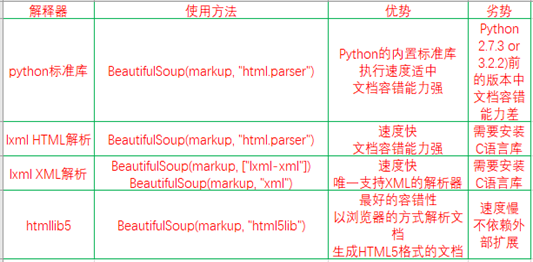一、导入模块
from bs4 import BeautifulSoup
二、创建对象
Beautiful Soup支持Python标准库中的HTML解析器,还支持一些第三方的解析器,如果我们不安装它,则 Python 会使用 Python默认的解析器,lxml 解析器更加强大,速度更快,推荐安装。

html = """ <html> <head><title>A Tale of Two Cities</title></head> <body> <p class="title" name="dromouse"><b>A Tale of Two Cities</b></p>
<p class="story">
It was the best of times;It was the worst of times. <a href="http://example.com/age" class="of" id="link1">It was the age of wisdom;it was the age of foolishness </a>.
<a href="http://example.com/epoch" class="of" id="link2">It was the epoch of belief;it was the epoch of incredulity </a>.
<a href="http://example.com/season" class="of" id="link3">It was the season of Light;it was the season of Darkness </a>.
It was the spring of hope;it was the winter of despair.
</p> <h2 class="story"> <!-- This is comment --> </h2>
<h3 class="hey"> Hey<!-- Now --> </h3>
<h4>Well Done</h4>
</body> </html> """ soup = BeautifulSoup(html, features="lxml") #另外,我们还可以用本地 HTML 文件来创建对象,例如 soup = BeautifulSoup(open('index.html'), features="lxml") #上面这句代码便是将本地 index.html 文件打开,用它来创建 soup 对象
三、对象的方法属性调用
1、对象归类
Beautiful Soup 将复杂HTML文档转换成一个复杂的树形结构,每个节点都是 Python 对象,所有对象可以归纳为4种:Tag,NavigableString,BeautifulSoup,Comment。
1)、TAG
print soup.p #获取p标签,它查找的是所有内容中第一个符合要求的标签 print soup.title #获取title标签 print soup.p.attrs #获取p标签属性 print soup.p["class"] #获取p标签的class属性值 print soup.p.get("class") #获取p标签的class属性值 soup.p['class']="newClass" #对p标签的class属性值进行修改
2)、NavigableString
既然我们已经得到了标签的内容,那么问题来了,我们要想获取标签内部的文字怎么办呢?很简单,用 .string 即可,例如:
print soup.p.string #获取标签的文本内容
3)、BeautifulSoup
BeautifulSoup 对象表示的是一个文档的全部内容.大部分时候,可以把它当作 Tag 对象,是一个特殊的 Tag,我们可以分别获取它的类型,名称,以及属性来感受一下:
print soup.name #获取soup的name:[document] print type(soup) #获取soup的name的类型:<type 'unicode'> print soup.attrs #获取soup的属性:{}
4)、Comment
Comment 对象是一个特殊类型的 NavigableString 对象,其实输出的内容仍然不包括注释符号,但是如果不好好处理它,可能会对我们的文本处理造成意想不到的麻烦。
print soup.h2.string #获取h2标签的文本内容是:This is comment print type(soup.h2.string) #类型是:<class 'bs4.element.Comment'> print soup.h3.string #获取h3标签的文本内容是:Hey print type(soup.h3.string) #类型是:<type 'NoneType'> print soup.h4.string #获取h4标签的文本内容是:Well Done print type(soup.h4.string) #类型是:<class'bs4.element.NavigableString'>
2、遍历对象--文档树
1)、子节点
print type(soup.p.children) # 类型是: <type 'listiterator'> print len(list(soup.p.children)) #获取子节点数 for i in soup.p.children: #遍历所有子节点 print i print type(soup.p.descendants) # 类型是: <type 'generator'> print len(list(soup.p.descendants)) #获取子节点数 for j in soup.p.descendants: #遍历所有子节点(但是它把每个节点文本内容也当成了一个循环遍历,所以遍历的时候可以直接获取内容) print j
2)、父节点
print type(soup.p.parent) # 类型是: <class 'bs4.element.Tag'> print len(list(soup.p.parent)) #获取父节点数 for i in soup.p.parent: #遍历父节点所有对象 print i print type(soup.p.parenst) # 类型是: <type 'generator'> print len(list(soup.p.parents)) #获取所有父节点数 for j in soup.p.parents: #遍历所有父节点的对象 print j
3)、兄弟节点
print type(bs.p.next_sibling) #p标签下一个兄弟标签类型是:<class 'bs4.element.Tag'> print len(list(bs.p.next_sibling)) #p标签下一个兄弟标签节点数 for i in bs.p.next_sibling: #遍历p标签下一个兄弟标签节点对象 print i #.next_sibling 属性获取了该节点的下一个兄弟节点。 .previous_sibling 则与之相反,如果节点不存在,则返回 None print type(bs.p.next_siblings) #p标签个所有标签类型是:<type 'generator'> print len(list(bs.p.next_siblings)) #p标签个所有兄弟标签节点数 for j in bs.p.next_siblings: #遍历p标签个所有兄弟标签节点对象 print j #.next_siblings 属性获取了该节点的下个所有兄弟节点。 .previous_siblings 则与之相反,如果节点不存在,则返回 None
4)、前后节点
#知识点:.next_element .previous_element 属性 #与 .next_sibling .previous_sibling 不同,它并不是针对于兄弟节点,而是在所有节点,不分层次 #比如 head 节点为:<head><title>The Dormouse's story</title></head> #那么它的下一个节点便是 title,它是不分层次关系的 print soup.head.next_element #<title>The Dormouse's story</title> #所有前后节点--知识点:.next_elements .previous_elements 属性 $通过 .next_elements 和 .previous_elements 的迭代器就可以向前或向后访问文档的解析内容,就好像文档正在被解析一样
5)、文本内容
print type(bs.p.string) #p标签内容类型是:<class 'bs4.element.NavigableString'> print len(list(bs.p.string)) #p标签内容节点数 print type(bs.p.strings) #p标签内容类型是:<class 'bs4.element.NavigableString'> print len(list(bs.p.strings)) #p标签所有内容节点数 for i in bs.p.strings: #遍历内容 print i #.strings获取多个内容,不过需要遍历获取,输出的字符串中可能包含了很多空格或空行,使用 .stripped_strings 可以去除多余空白内容
3、搜索文档树
1)、find_all( name , attrs , recursive , text , **kwargs )

#传字符串 '''最简单的过滤器是字符串.在搜索方法中传入一个字符串参数,Beautiful Soup 会查找与字符串完整匹配的内容,下面的例子用于查找文档中所有的 标签''' soup.find_all('b') #传正则表达式 '''如果传入正则表达式作为参数,Beautiful Soup 会通过正则表达式的 match() 来匹配内容.下面例子中找出所有以b开头的标签,这表示 和 标签都应该被找到''' soup.find_all(re.compile("^b")) #传列表 '''如果传入列表参数,Beautiful Soup 会将与列表中任一元素匹配的内容返回.下面代码找到文档中所有 <a> 标签和 <b> 标签''' soup.find_all(["a", "b"]) #传 True '''True 可以匹配任何值,下面代码查找到所有的 tag,但是不会返回字符串节点''' soup.find_all(True) #传方法 '''如果没有合适过滤器,那么还可以定义一个方法,方法只接受一个元素参数 [4] ,如果这个方法返回 True 表示当前元素匹配并且被找到,如果不是则反回 False 下面方法校验了当前元素,如果包含 class 属性却不包含 id 属性,那么将返回 True''' def has_class_but_no_id(tag): return tag.has_attr('class') and not tag.has_attr('id') soup.find_all(has_class_but_no_id) #keyword 参数 '''注意:如果一个指定名字的参数不是搜索内置的参数名,搜索时会把该参数当作指定名字 tag 的属性来搜索,如果包含一个名字为 id 的参数,Beautiful Soup 会搜索每个 tag 的 ”id” 属性 soup.find_all(id='link2') 如果传入 href 参数,Beautiful Soup 会搜索每个 tag 的 ”href” 属性 soup.find_all(href=re.compile("elsie")) 使用多个指定名字的参数可以同时过滤 tag 的多个属性 soup.find_all(href=re.compile("elsie"), id='link1') 在这里我们想用 class 过滤,不过 class 是 python 的关键词,这怎么办?加个下划线就可以 soup.find_all("a", class_="sister") 有些 tag 属性在搜索不能使用,比如 HTML5 中的 data-* 属性 data_soup = BeautifulSoup('<div data-foo="value">foo!</div>') data_soup.find_all(data-foo="value") # SyntaxError: keyword can't be an expression 但是可以通过 find_all() 方法的 attrs 参数定义一个字典参数来搜索包含特殊属性的tag data_soup.find_all(attrs={"data-foo": "value"})''' #text 参数 '''通过 text 参数可以搜搜文档中的字符串内容.与 name 参数的可选值一样, text 参数接受 字符串 , 正则表达式 , 列表, True soup.find_all(text="Elsie")''' #limit 参数 '''find_all() 方法返回全部的搜索结构,如果文档树很大那么搜索会很慢.如果我们不需要全部结果,可以使用 limit 参数限制返回结果的数量.效果与 SQL 中的 limit 关键字类似,当搜索到的结果数量达到 limit 的限制时,就停止搜索返回结果. 文档树中有3个 tag 符合搜索条件,但结果只返回了2个,因为我们限制了返回数量 soup.find_all("a", limit=2)''' #recursive 参数 '''调用 tag 的 find_all() 方法时,Beautiful Soup 会检索当前 tag 的所有子孙节点,如果只想搜索 tag 的直接子节点,可以使用参数 recursive=False。'''
2)、find( name , attrs , recursive , text , **kwargs )
3)、find_parents() fin_parent()
4)、find_next_siblings() find_next_sibling()
5)、find_previous_siblings() find_previous_sibling()
6)、find_all_next() find_next()
7)、find_all_previous() 和 find_previous()
4、css选择器
我们在写 CSS 时,标签名不加任何修饰,类名前加点,id名前加#,在这里我们也可以利用类似的方法来筛选元素,用到的方法是 soup.select(),返回类型是 list。
1)、通过标签名查找
print soup.select('title') #[<title>The Dormouse's story</title>]
2)、通过类名查找
print soup.select('.sister') #[<a class="sister" href="http://example.com/elsie" id="link1"><!-- Elsie --></a>, <a class="sister" href="http://example.com/lacie" id="link2">Lacie</a>, <a class="sister" href="http://example.com/tillie" id="link3">Tillie</a>]
3)、通过 id 名查找
print soup.select('#link1') #[<a class="sister" href="http://example.com/elsie" id="link1"><!-- Elsie --></a>]
4)、组合查找
组合查找即和写 class 文件时,标签名与类名、id 名进行的组合原理是一样的,例如查找 p 标签中,id 等于 link1 的内容,二者需要用空格分开
print soup.select('p #link1') #[<a class="sister" href="http://example.com/elsie" id="link1"><!-- Elsie --></a>] #直接子标签查找 print soup.select("head > title") #[<title>The Dormouse's story</title>]
5)、属性查找
查找时还可以加入属性元素,属性需要用中括号括起来,注意属性和标签属于同一节点,所以中间不能加空格,否则会无法匹配到。
print soup.select('a[class="sister"]') #[<a class="sister" href="http://example.com/elsie" id="link1"><!-- Elsie --></a>, <a class="sister" href="http://example.com/lacie" id="link2">Lacie</a>, <a class="sister" href="http://example.com/tillie" id="link3">Tillie</a>] print soup.select('a[href="http://example.com/elsie"]') #[<a class="sister" href="http://example.com/elsie" id="link1"><!-- Elsie --></a>] #同样,属性仍然可以与上述查找方式组合,不在同一节点的空格隔开,同一节点的不加空格 print soup.select('p a[href="http://example.com/elsie"]') #[<a class="sister" href="http://example.com/elsie" id="link1"><!-- Elsie --></a>]
